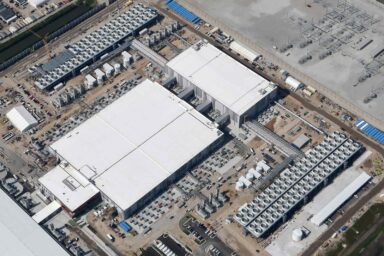The billion-dollar redevelopment of a housing project in the South Los Angeles community of Watts raises disturbing questions about lead contamination in the soil, air, and water — and how Latino and African American children are already suffering the impacts.
The whole world knows the story of Flint by now. The famously depressed city in Michigan, where the majority of residents are African American, shifted its drinking-water source to a local river in 2014 in order to save money. Residents’ complaints about the terrible-smelling murky water that began spewing from their taps were largely ignored. As it turned out, they were being poisoned by lead contamination from years of industrial-waste dumping. Eventually, a state of emergency was declared.
But Flint is not alone. Across the country, for example, there’s another impoverished community you might have heard of — this one near the golden shores of Southern California. Watts, located on a mere 2.1 square miles in South Central Los Angeles, isn’t suffering the immediate effects observed in Flint. Not yet. But the causes of pollution recently detected under a 58-year-old housing project — and the reluctance of officials to address the situation — are much the same.
Perhaps no other community of 40,000-some people has received as much notoriety as Watts. It was a flashpoint of a major African American uprising against police brutality in 1965, and again following the acquittal of the four officers who beat Rodney King in 1992.
Although considered by outsiders to be one of the country’s most dangerous and crime-ridden areas, Watts is also home to two remarkable sculptural monuments, the Watts Towers and the Mother of Humanity.
“Watts was for the West Coast what Harlem was to New York,” according to Orland Bishop of the ShadeTree Multicultural Foundation, “and it holds the historical ground for creativity on this level.”
“Never did I think we were going to face a billion-dollar development that ignores the poison beneath its feet.”
Today, in one of the ironies common to urban redevelopment schemes, an effort to improve Watts may actually be making things worse. The billion-dollar makeover of a sprawling housing project that’s been plagued for decades by contamination from industrial sources threatens to endanger the very residents it is supposed to help.
Testing of the site has shown toxic levels of lead and other deadly chemicals. Residents have urged that redevelopment should not move forward unless these problems are addressed. But state and city regulators have ignored them.

Jordan Downs, originally built as temporary housing for steelworkers during World War II, currently crowds some 2,400 tenants (over half of them children under 18) in its 700 cinderblock low-income units that used to be predominantly African American. Due to a major demographic shift over the past two decades, more than 70 percent of residents are now Latino.
Buoyed by grant money from the US Department of Housing and Urban Development (HUD), LA Mayor Eric Garcetti hosted a groundbreaking ceremony last summer to begin demolition of the old Jordan Downs complex in favor of a mixed-income “Urban Village” with double the number of apartments and a shopping center.
But residents fear that the site is still contaminated.

Back in 2009, soil samples taken on a 21-acre city-owned lot inside the development showed high levels of diesel fuel, oil, and polychlorinated biphenyls (PCBs) — residue from the steel mill that had long operated on the site.
After more than 259,000 tons of dirt laced with lead and arsenic got hauled away, the people of Jordan Downs were assured that it was safe for construction of 115 new units, 72 of them reserved for current residents in good standing. They have been promised they will not be displaced during construction, and will remain at the same rental rate of one-third their monthly income (the average yearly wage is $16,000, and nearly one-quarter of the project’s adults are unemployed).
Yet Pahola Ybarra, program director for the Watts Century Latino nonprofit organization, recalls people suffering asthma attacks from all the dust in the air during the soil replacement, and she wonders: “Are we breathing in the lead they’re supposed to be cleaning up?” (According to the California Department of Public Health, Watts has one of the highest incidences of respiratory disease in the US.)
Not that it’s safe where they’re living now. Also in 2009, an interoffice memo within the Housing Authority of the City of LA (HACLA) conceded that residential portions of the existing 54-year-old housing project “might require remediation.” Another five years passed before California’s Department of Toxic Substance Control (DTSC) took soil tests around the perimeter wall, detecting elevated levels of lead and arsenic in about half the samples. Yet with the redevelopment looming, the DTSC issued a “No Further Action” determination, meaning that the residential area itself wouldn’t be tested.
The senior toxicologist responsible for that decision was discovered to be engaged in a racially charged email exchange with another DTSC scientist, including crude ethnic references to an “injun badge” and “crack ho hooker.”
The department released the emails in December 2015 after a public records request. A letter signed by over 40 environmental activists asked Governor Jerry Brown and lawmakers to probe whether racism was widespread in the agency, which offered assurances that the employees had been disciplined and promised to review their decision not to pursue testing at Jordan Downs. Other than a week of paid time off, no further action was taken against the toxicologist, and no further results have been forthcoming.
A coalition of environmental justice groups subsequently enlisted an X-ray fluorescence analyst to take over 100 soil samples in and around the homes. Tests showed over half the samples to be above the state’s 80 parts-per-million lead threshold. An air sample also found lead at over 200 times the California EPA’s standard.
Tim Watkins, CEO of the nonprofit Watts Labor Community Action Committee, purchased equipment to do its own testing; results indicated soil surface contamination at highly actionable levels. Watkins explained to WhoWhatWhy: “Lead doesn’t dissipate, it accumulates and it gets walked into those homes. I think the lead problem there is worse than the one getting all the attention in Flint.”
According to the Centers for Disease Control, lead is a potent neurotoxin with no safe level of exposure. Young children are at the greatest risk: Even miniscule amounts of lead can cause learning disabilities, lower IQs, and other permanent developmental and behavioral problems.
“Lead exposure around their homes has definitely affected the behavior of our children all across Watts,” Ybarra said. “It makes them more aggressive and it shortens their attention span, among other obvious health issues.”
When Jordan Downs community members found it difficult to get information at public meetings with the DTSC, who used their “jargon to confuse us and to make us feel uneducated and in the wrong for even questioning,” Ybarra organized backyard briefings by the Housing Authority.
But after officials declared the cleanup a success, more toxins were found. In May 2016, tests showed high levels of the industrial solvents trichloroethylene and tetrachloroethylene — known causes of birth defects and cancer — in groundwater and soil vapors where the new retail center is slated to be built. It turned out that a plume of these chemicals had migrated from an off-site source, most likely a nearby ExxonMobil pipeline that’s apparently been leaking for years.
“When I see kids going to the water fountains, I stop them.”
Yet in 2017, the DTSC “determined that there is no potential risk [and] … no further action is required.” It did, however, recommend that new buildings include barriers to block any chemicals from seeping inside.
“This is not a plan to clean up contamination,” said attorney Alexander Harnden of the Legal Aid Foundation of Los Angeles. “It’s a plan to prevent it from moving through the foundations of the commercial buildings. It does nothing to keep that incredibly dangerous stuff from moving towards the housing.”
Nor is this the only problem. Another underground plume of toxic chemicals has been found under Jordan High School, which shares a border with the new development. The LA Unified School District is suing the city for over $1 million about who should pay for the cleanup. Critics charge that Los Angeles officials are so concerned about keeping the federal dollars for this project, they’re willing to rush the construction, despite these warning signs.
Developer Bridge Housing is already one year into construction on the first phase of the project, and a resolution adopted by the LA City Council has authorized a $32.6 million bond sale to finance the second phase.

Construction proceeds, despite the fact that Jordan Downs — because of its proximity to toxic cleanup sites, air pollution, and poverty — is now considered one of California’s most environmentally vulnerable neighborhoods.
Yet, residents are reluctant to speak out.
“It’s a difficult subject to address when you’re just trying to get food on the table,” Ybarra said. “And a lot of the people here live in fear based on the [Trump] administration. Even naturalized citizens are not safe right now. So it’s not high on people’s priority list but it should be, because this directly affects the school-to-prison pipeline. When kids can’t pay attention in school, told they’re bad because they can’t focus or are acting out, I’m 90 percent sure that most of that could be traced back to some form of lead exposure around their home.”
“Scientists from the State Water Board have talked about finding petroleum byproducts in testing wells for the water table that travels southwest under Watts,” Tim Watkins informed a Town Hall meeting in 2017, “yet they can’t tell us how far it’s gone, how deep it is, and what effect it has on the people living above it.”
In 2017 came the preliminary findings of a study conducted by the Jordan Downs Environmental Justice Coalition and the Harbor UCLA Medical Center. About 90 percent of the 85 participants described brown, rusty, or murky water flowing from their taps at Jordan Downs, with 95 percent believing their water unsafe to drink.
According to Watkins, “all the schools more than thirty years old have lead leaching into the drinking water.” Crystal White, a high school special-ed teacher whose students come from several housing projects, including Jordan Downs, had tears in her eyes as she addressed the Town Hall meeting about “their impulsivity, their inability to control their anger. It kills me, and that in turn is killing our teaching staff because they can’t handle it. Of course, aside from the poisons, there are the impacts of trauma and the exposure to violence. In their hearts, these are good children. How do you treat the whole child so this stops happening?”
White continued: “We had the LA Department of Water and Power come out and say, it looks like all the lead is at the source. That doesn’t make sense, but the bottled water deliveries we had been receiving just stopped. The teachers are having to buy water because the school can’t figure out who to go after. When I see kids going to the water fountains, I stop them.”
“My research has shown a direct correlation between lead contamination, hyperactivity, and growth retardation,” Dr. Rasheeda Hawk, a professor of Life Sciences at Santa Monica College, told WhoWhatWhy. “But it’s very affordable to remediate soils, as well as water, through a process known as Bioremediation.” That is how Hawk plans to engage her students in addressing the contamination in Watts, using microorganisms to break down pollutants.
Community leaders like Tim Watkins are also calling for mitigation. As Watkins summarized to WhoWhatWhy: “Remediation is what everyone looks for in an environmental disaster, but what about the harm that was already produced by it? I try to live out my father’s edict, which was: ‘Don’t move, improve.’ Don’t run from Watts because it has issues, make it better. But never did I think we were going to face a billion-dollar development that ignores the poison beneath its feet.”
Dick Russell is a Los Angeles–based author of thirteen books, including the 2017 Horsemen of the Apocalypse: The Men Who Are Destroying Life on Earth — And What It Means For Our Children.
Related front page panorama photo credit: Adapted by WhoWhatWhy from lead graphic (CDC), Watts (Darkest tree / Wikimedia – CC BY-SA 3.0).


